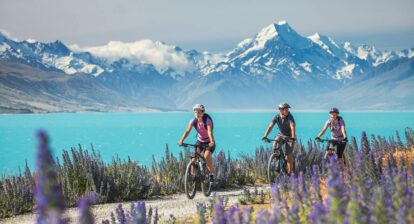Seasons in New Zealand
Whether you’re searching for outside experience, family tomfoolery, rest and unwinding, food and wine, social encounters or a touch of everything, New Zealand has something to suit, regardless of when you visit.
New Zealand’s occupied ‘high season’ is summer, while the calmer ‘shoulder seasons’ are spring and fall. Winter in New Zealand can be occupied or calm relying upon where you go – ski regions like Queenstown and Wanaka in the South Island and the Central Plateau in the North Island are continuously humming in the profundities of winter, though seaside regions and enormous urban communities like Auckland and Wellington are less packed. Going in the shoulder seasons can be smart as you’ll frequently track down additional accessibility and better rates on convenience and exercises.
Summer (December-February)
Church building Cove
The Coromandel
Basilica Cove, The Coromandel
By Bush and Beach
This is the most famous opportunity to visit New Zealand for bright ocean side days, undertakings on the water, wonderful hedge strolls and mountain climbing. Guest numbers are high and summer occasions mean more Kiwis are going around New Zealand as well, capitalizing on the daylight and Christmas break.
Pre-winter (March-May)
Clutha Gold Trail – Autumn
Clutha
Clutha Gold Trail – Autumn, Clutha
By shebikeshebikes
On the off chance that you would like daylight however less groups, pre-winter is a fabulous opportunity to visit New Zealand. The days are still very warm right off the bat in the season (that implies ocean side swims through March and well into April in certain pieces of the country) with cooler nights, and there is wonderful landscape as the harvest time colors spread through the open country. Hedge strolls and climbing are extraordinary choices now as the days are not as hot.
Winter (June-August)
Playing in the snow at Ruapehu
Ruapehu
Playing in the snow at Ruapehu, Ruapehu
By Visit Ruapheu
Winter in New Zealand is the best opportunity to visit assuming you’re into snow sports. Queenstown and Wanaka in the South Island and the Central Plateau in the North Island are the most well known spots for skiing and snowboarding. While many ski fields open in June, the most elevated snowfall is generally all through July and August. Assuming you’re anticipating driving in areas of New Zealand that are inclined to snow, you’ll have to convey chains and take additional consideration on the streets.
Spring (September-November)
Hagley Park
Christchurch – Canterbury
Hagley Park, Christchurch – Canterbury
By Julian Apse
Spring in New Zealand is the point at which the weather conditions begins to heat up, in spite of the fact that there is a high opportunity of precipitation close to this season. It’s the ideal chance to appreciate outside exercises like climbing, and there is much of the time spring skiing accessible at some ski fields as well. You’ll find New Zealand’s field brimming with bobbing sheep and spring blooms, so it makes for incredible photographs! Warm days and cool evenings are normal.
Summer
December – February
Normal daytime temperature:
20 – 25˚C (68 – 77˚F)
Peruse more about summer
Pre-winter
Walk – May
Normal daytime temperature:
17 – 21˚C (62 – 70˚F)
Peruse more about pre-winter
Winter
June – August
Normal daytime temperature:
12 – 16˚C (53 – 61˚F)
Peruse more about winter
Spring
September – November
Normal daytime temperature:
16 – 19˚C (61 – 66˚F)
Peruse more about spring
Local Temperatures
Mean everyday temperature
Month Celsius Fahrenheit
Jan 19.1 66.4
Feb 19.7 67.5
Mar 18.4 65.1
Apr 16.1 61
May 14 57.2
Jun 11.8 53.2
Jul 10.9 51.6
Aug 11.3 52.3
Sep 12.7 54.9
Oct 14.2 57.6
Nov 15.7 60.3
Dec 17.8 64
Normal precipitation
Month mm
Jan 73.3
Feb 66.1
Mar 87.3
Apr 99.4
May 112.6
Jun 126.4
Jul 145.1
Aug 118.4
Sep 105.1
Oct 100.2
Nov 85.8
Dec 92.8
Environment information from NIWA, the National Institute of Water and Atmospheric Research
Climate in New Zealand
Temperatures in New Zealand are for the most part gentle, yet the weather conditions can fluctuate a ton around the nation and could change rapidly as we are a somewhat tight island country. Local people like to joke that you can encounter four seasons in a single day! It pays to be ready for what you could experience on your movements.
New Zealand’s environment is different – the north of the North Island can have warm subtropical weather conditions in summer, while inland elevated region of the South Island can have weighty snow and temperatures as low as – 10°C (14°F) in winter.
The most sizzling a very long time in New Zealand are January and February, and the coldest month of the year is July. The typical temperature in New Zealand diminishes as you travel south.
Downpour, snow and sun
New Zealand is rich and green on purpose! Our typical precipitation is high and spread equally consistently. Anything season you are visiting, pack a waterproof shell as no one can really tell when you could get showers.
Snow commonly falls during the long stretches of June through to October, however cool fronts can happen beyond this. Most snow in New Zealand falls in the rugged regions, similar to the Central Plateau in the North Island, and the Southern Alps in the South Island. It likewise falls vigorously in inland Canterbury and Otago in the South Island. It seldom snows in the waterfront region of the North Island, despite the fact that they experience a few weighty short-term ices in winter.
The sunniest spots in New Zealand (recorded long periods of daylight) are the Bay of Plenty, Hawke’s Bay and Nelson/Marlborough. As New Zealand notices Daylight Saving, sunlight can endure up until 9.30pm during late spring months.
Be SunSmart
The sun in New Zealand is a lot more grounded than somewhere else and in hotter months you can get singed rapidly without sunscreen or other sun security. This is on the grounds that we have generally little air contamination contrasted and numerous different nations, and less ozone, which makes the UV beams in our daylight exceptionally impressive.
Take specific consideration from September to April, particularly somewhere in the range of 10am and 4pm, even on overcast days. Be ‘SunSmart’ by utilizing these three straightforward advances when you go outside:
Remain in the shade whenever the situation allows.
Wear a shirt, cap and shades.
Use SPF 30+ sunscreen. Reapply like clockwork and in the wake of swimming.
You can check New Zealand atmospheric conditions on the MetService website.(opens in new window)
sourced by www.newzealand.com



Customer Reviews
Thanks for submitting your comment!